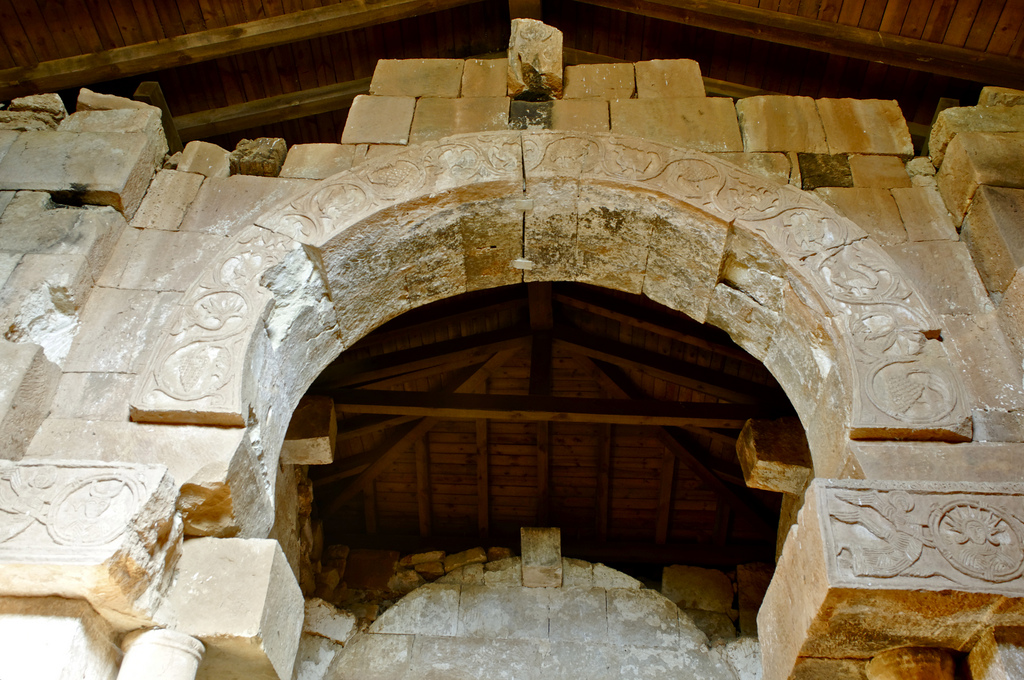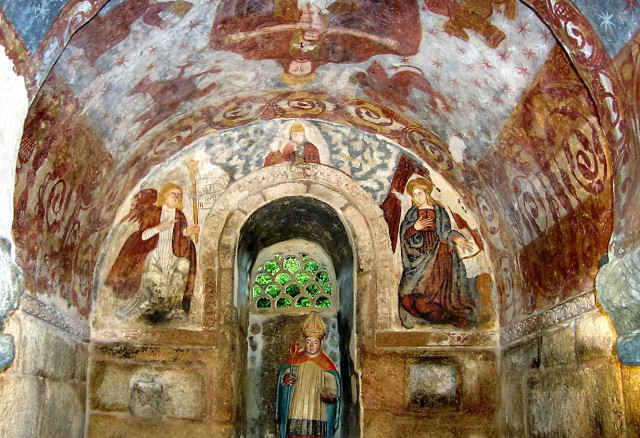7


















| Thumbs Up |
| Received: 4,400 Given: 2,644 |

The Visigoths entered Hispania (modern Spain and Portugal) in 415, and they rose to be the dominant people there until the Moorish invasion of 711 brought their kingdom to an end.
This period in Iberian art is dominated by their style. Visigothic art is generally considered in the English-speaking world to be a strain of Migration art, while the Portuguese and Spanish-speaking worlds generally classify it as Pre-Romanesque.
Branches of Visigothic art include their architecture, their crafts (especially jewellery), and even their script.
Visigothic architecture
The only remaining examples of their architecture from the 6th century are the church of San Cugat del Vallés in Barcelona, the hermitage and church of Santa Maria de Lara in Burgos, Saint Frutuoso Chapel in (Braga), the church of São Gião in (Nazaré) and the few remnants of the church at Cabeza de Griego, Cuenca. However, their style developed over the next centuries, though the prime remaining examples of it are mostly rural and often run-down. Some of the characteristics of their architecture are:
Generally basilican in layout, sometimes a Greek cross plan or, more rarely, a combination of the two. The spaces are highly compartmentalised.
Horseshoe arches without keystones.
A rectangular, exterior apse.
Use of columns and pillars with Corinthian capitals of unique design.
Barrel vaults with cupolas at the crosses.
Walls of ashlar blocks, occasionally alternating with Roman brickwork.
Decoration commonly of animal or plant motifs.
Exemplars include:
Church of San Juan Bautista in Baños de Cerrato (province of Palencia)
Crypt of San Antolín in the cathedral of Palencia (province of Palencia)
Church of San Pedro de la Nave in San Pedro de la Nave-Almendra (province of Zamora)
Church of Santa Comba in Bande (province of Ourense)
Chapel of San Xes (or San Ginés) de Francelos in Ribadavia (province of Ourense)
Church of San Pedro de la Mata (in ruins) in Sonseca (province of Toledo)
Church of Santa María de Melque in San Martín de Montalbán (province of Toledo)
Suso monastery at San Millán de la Cogolla, La Rioja
Basilica of Santa María de Batres in Carranque (province of Toledo)
Hermitage of Santa María in Quintanilla de las Viñas (province of Burgos)
Church of Santa Lucía del Trampal near Alcuéscar (province of Cáceres)
crypt of the monastery of San Salvador de Leyre, Navarre
Head of the Church of San Miguel de los Fresnos (in ruins) in Fregenal de la Sierra (province of Badajoz)
Saint Frutuoso Chapel in Braga, (Portugal)
Church of São Gião in Nazaré, (Portugal)
San Juan de Baños 661 AD

Last edited by Jacques de Imbelloni; 05-02-2018 at 12:43 AM.
















| Thumbs Up |
| Received: 4,400 Given: 2,644 |

iglesia de san pedro de la nave zamora
La iglesia visigoda de San Pedro de la Nave se encuentra situada en la localidad de El Campillo, término municipal de San Pedro de la Nave-Almendra, en la provincia de Zamora (España). Fue declarada Monumento Nacional el 22 de abril de 1912 (publicado en el BOE de 29-04-1912).
El templo se remonta a finales del siglo VII, pues debió construirse entre los años 680 y 711, es decir, en los años previos a la conquista musulmana, por lo que puede tratarse de una de las últimas obras del arte visigodo.

















| Thumbs Up |
| Received: 4,400 Given: 2,644 |

Hermitage of Santa María de Lara
The church of Santa María de Lara, also known as the Ermita (English: hermitage) de Santa María, is one of the last surviving Visigoth churches on the Iberian Peninsula,[1] located near the village of Quintanilla de las Viñas,[2] not far from the city of Burgos, in the Castile and León region in Spain,[3] Archeologists have yet to confirm its period of construction but the church has been placed by scholars have placed it between the 7th century, where it is more frequently located, and the 10th century.[4][5][6] The church is notable not only for its age and architectural type, but also because it is believed to contain the earliest representation of Christ in Spanish religious art.[1] It was classified as a national monument on November 25, 1929.

















| Thumbs Up |
| Received: 4,400 Given: 2,644 |

Iglesia de Santa Comba (Bande)
Santa Comba de Bande es un templo visigodo posiblemente de la segunda mitad del siglo VII, situado en el municipio de Bande en la provincia de Orense.
Con planta de cruz griega y perímetro rectangular del que sobresale por la cabecera del rectángulo la capilla mayor y por los pies, el pórtico. El perímetro rectangular queda dibujado por estancias a ambos lados del pórtico que comunicaban con este, otras con el transepto y las de la cabecera con la nave.
Tanto en planta como en alzado conjuga la cruz griega inscrita en un cuadrado, cuyo punto central se eleva mediante el cimborrio.
El escalonamiento de los volúmenes del templo, de lo más alto a lo más bajo, va así del cimborrio a la capilla mayor, pasando por la altura media de los brazos de la cruz.
Se cubre con bóveda de cañón en nave y transepto, con bóveda de arista en el tramo central del crucero y bóveda de herradura en la capilla mayor.

















| Thumbs Up |
| Received: 4,400 Given: 2,644 |

Treasure of Guarrazar
The Treasure of Guarrazar, Guadamur, Province of Toledo, Castile-La Mancha, Spain, is an archeological find composed of twenty-six votive crowns and gold crosses that had originally been offered to the Roman Catholic Church by the Kings of the Visigoths in the seventh century in Hispania, as a gesture of the orthodoxy of their faith and their submission to the ecclesiastical hierarchy.[2] The most valuable of all is the votive crown of king Reccesuinth with its blue sapphires from Sri Lanka and pendilia. Though the treasure is now divided and much has disappeared, it represents the best surviving group of Early Medieval Christian votive offerings.
The treasure, which represents the high point of Visigothic goldsmith's work,[3] was dug between 1858 and 1861 in an orchard called Guarrazar, in Guadamur, very close to Toledo, Spain. The treasure was divided, with some objects going to the Musée de Cluny in Paris[4] and the rest to the armouries of the Palacio Real in Madrid (today in the National Archaeological Museum of Spain). In 1921 and 1936, some items of the Treasure of Guarrazar were stolen and have disappeared.
Some comparable Visigothic filigree gold was found in 1926 at Torredonjimeno in the province of Jaén, consisting of fragments of votive crowns and crosses.
Description
The jewellery found at Guarrazar is part of a continuous tradition of Iberian metalworking that goes back to prehistoric times. These Visigothic works were influenced heavily by the Byzantines, but the techniques of gem encrustation found at Guarrazar were practised throughout the Germanic world and the style of the lettering was Germanic too. The crowns, however, were purely Byzantine in form and never meant to be worn. They were gifts to the church, to be hung above the altar.
The most valuable remaining pieces of the find are the two royal votive crowns: one of King Reccesuinth and one of King Suinthila. Both are made of gold, encrusted with sapphires, pearls, and other precious stones. Suinthila's was stolen in 1921 and never recovered. There are several other small crowns and many votive crosses. There were belts in the original find as well, but these have since vanished.
These findings, together with other of some neighbors and with the archaeological excavation of the Ministry of Public Works and the Royal Academy of History (April 1859), formed a group consisting of:
National Archaeological Museum of Spain: six crowns, five crosses, a pendant and remnants of foil and channels (almost all of gold).
Royal Palace of Madrid: a crown and a gold cross and a stone engraved with the Annunciation. A crown, and other fragments of a tiller with a crystal ball were stolen from the Royal Palace of Madrid in 1921 and its whereabouts are still unknown.
National Museum of the Middle Ages, Paris: three crowns, two crosses, links and gold pendants.
There were also many fragments of sculptures and the remains of a building, perhaps a Roman sanctuary or place of purification. After its dedication to Christian worship as a church or oratory, it housed a number of graves. A skeleton lying on a bed of lime and sand was found in the best preserved grave. Its well-preserved stone slate has a Latin inscription that mentions a priest named Crispín, dating from 693 (51st year of the reign of Égica, year of the Sixteenth Council of Toledo). This slate is now in the National Archeological Museum of Spain in Madrid. The inscription on the Sónnica cross, a piece preserved in Paris, gives an indication about the name of this church.
INDNI
NOM
INE
OFFERET SONNICA
ACTE
MA
RIE
INS
ORBA
CES
According to some hypothesis, the monastery of Sancta Maria in Sorbaces of Guarrazar served as a hideout for the real treasure of the court, Toledo churches and monasteries to prevent their capture by the Muslims' invasion of Spain.

















| Thumbs Up |
| Received: 4,400 Given: 2,644 |

El ajuar de las necrópolis visigodas de Segovia
Posiblemente, el aspecto más sobresaliente del Museo de Segovia es su colección de ajuar visigodo. Son numerosas e importantes las necrópolis visigodas localizadas a lo largo y ancho de la provincia: Espirdo, Cozuelos de Fuentidueña, Duratón, Aguilafuente, etc.
Hasta su remansamiento tras la caída del Imperio Romano, los pueblos germánicos eran nómadas por lo que, en un principio, no desarrollaron manifestaciones arquitectónicas. Por el contrario, volcaron sus aptitudes artísticas en objetos que pudieran transportar fácilmente de unos asentamientos a otros, como es la orfebrería, especialmente aplicada al uso personal (joyería).
Este aspecto, unido a su costumbre de enterrar a los fallecidos con los mejores ajuares, ha proporcionado innumerables piezas de sus necrópolis como collares, pendientes y, muy especialmente, fíbulas y hebillas de cinturón.
La mayoría de estos pequeños pero interesantes objetos son de bronce con piedras semipreciosas y/o pastas vítreas de colores amarillos y rojos.
Dentro de la categoría de las fíbulas se exponen un buen número de la modalidad más sencilla llamada de "puente" aunque también hay una de tipo aquiliforme, sin duda las más valiosas y espectaculares.
Por su parte, los broches de cinturón son también muy numerosos y de gran calidad. Suelen ser piezas rectangulares con siluetas tabicadas siguiendo diseños basados en motivos geométricos. En dichos tabiques se engastan cabujones o, con mayor frecuencia, pastas vítreas coloreadas.




















| Thumbs Up |
| Received: 110 Given: 122 |

This is very interesting, good post. Thanks brother.
















| Thumbs Up |
| Received: 4,400 Given: 2,644 |
















| Thumbs Up |
| Received: 2,656 Given: 332 |

Very interesting, it looks still influenced by late Roman and early Byzantines architectures.
Non Auro, Sed Ferro, Recuperanda Est Patria (Not by Gold, But by Iron, Is the Nation to be Recovered) - Marcus Furius Camillus (Roman General)
















| Thumbs Up |
| Received: 4,400 Given: 2,644 |

There are currently 1 users browsing this thread. (0 members and 1 guests)
Bookmarks